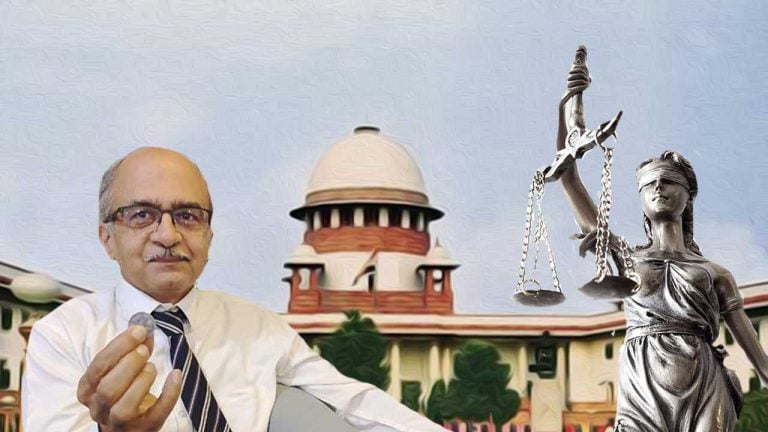

The Supreme Court in the case of suo motu contempt against Prashant Bhushan by a detailed order comprising of 82 pages concerning the affliction of sentence vide para (91) and observed that “In our considered view, the act committed by the contemnor is a very serious one. He has attempted to denigrate the reputation of the institution of administration of Justice of which he himself is a part. At the cost of repetition, we have to state that the faith of the citizens of the country in the institution of Justice is the foundation for the rule of law which is an essential factor in the democratic setup.”
The sentence awarded to him is a historical one in the sense, wherein, he has been awarded a fine of rupees one only and to be paid by latest of 15th of September else shall suffer the simple imprisonment of 3 months and further shall be deprived of the practice for 3 years. Section 12 of the Act mandates in clear terms that the punishment would be with simple imprisonment for a term which may extend to six months, or with a fine which may extend to two thousand rupees, or with both.

Strangely, the Prashant has also been sentenced in the event of default, he would be ineligible to appear before any court of law for three years. The law is well settled from times memorial that the courts of law can neither supplement nor supplant the law. Unfortunately the Supreme Court by afflicting the sentence of debarment has supplanted the law which is untenable and merits to be revisited.
The great irony of the judgment is that it is suffering from ‘the doctrine of dichotomy’. The reason for that is at the one hand vide para referred above, it has been judicially construed that serious contempt has been committed.
Contrarily the lightest of the light punishment has been inflicted which speaks volumes about the judicial wisdom of the Supreme Court. It appears from the tone and tenor of the judgment that the Supreme Court directly or indirectly has been swayed by the wide discussion in the public, media including the electronic media.And it has adversely impacted the quantum of sentence.
The observation of the Supreme Court that we have shown magnanimity while reflecting the sentence is judicially misplaced especially when vide para (87) a finding was recorded that “He is insistent and has no remorse about what he has stated in defense” and further observed in most explicit terms in the later part of the para that “even our request made to him has gone in vain. Thus, we feel that the simple issuance of warning is not going to suffice in the instant case” and further observed vide para (90) that “the court, from the very beginning, was desirous of giving quietists to this matter. Directly or indirectly, the contemnor was persuaded to end this matter by tendering an apology”.
It is the settled law by the long line of uninterrupted judicial pronouncements having the force of article 141 of the Constitution of India that the sentence must be awarded proportionate to the magnitude of the offence. But the Supreme Court while passing the judgment of conviction took the recourse to the advice of the Attorney General of India. It is quite shocking that how the advice of the Attorney General will prevail at a later stage.

The Attorney General has also requested that the Supreme Court not hold him guilty but the Supreme Court flatly declined to adhere to the same and he was held guilty. The judgment of holding him guilty passed on 14.08.2020 comprising of 108 pages which if examined even cursorily would reveal that the major part of the judgment is nothing but the facts leading to the initiation of proceedings and reproduction of the law of precedents. The subjective satisfaction for proceeding objectively in tune with 2(c) of the Act has not been dilated.
The Supreme Court has not clarified in specific terms as to how the two tweets coupled with the averments in the reply affidavits were found to be capacious and capable to shake the confidence of the public at large.
Section 2 (c) of The Contempt of Court Act, 1971 is based upon the entirely subjective satisfaction of the judges’. The subjective satisfaction differs from judge to judge and the live example of the same is that the Supreme Court while passing the judgment against Subrata Roy held against the stalwarts who were representing Subrata Roy that “attempts to overawe the courts with psychological offensives and mind games, with ferocity and grandiloquence without any factual basis, strongly repulsed and stringently deprecated“.
The aforesaid, observation leaves no room of doubt that the advocates did everything at their command to intimidate the court right before the eyes of the court. But the subjective satisfaction in terms of section 2(c) of the Act was not found to be proceeded for committing the criminal contempt.
The other disturbing feature of the judgment is that post the judgment of holdings guilty on 14th August 2020, the other hearings were held on different dates to measure the quantum of sentence.

The fleeting reading of the judgment would reveal in no uncertain terms that Supreme Court tried its best to persuade directly or indirectly, the contemnor to tender unconditional apology so that the contemnor be let off the hook. The contemnor through and through maintained a stiff stature and said in explicit words that come what may, he would stand by the tweets posted by him.
I am appalled and amused by the approach of the Supreme Court to persuade directly or indirectly the contemnor to tender unconditional apology. The law on this issue is well settled beyond any shred of doubt that in the contempt proceedings, the apology if to be tendered it must be tendered at the first available opportunity and not after holding the contemnor guilty for committing contempt.
In the present case, a different yardstick has been applied and it has certainly lowered the reverence of the Supreme Court. The observance of the Supreme Court regarding the press conference held by the four judges of the Supreme Court was completely uncalled for that we think that it will not be repeated.
The Legislature, in its Soloman wisdom in tune with Article 14 of the Constitution of India, has enacted the law of contempt not only for the lawyers or litigants but also for everyone including the judges who dares to commit contempt given to section 16 of the Contempt of Court Act.
It is clear beyond any cavil that the law of contempt is the same whether it is a judge or the activist lawyer or the philanthropist or any other person. The age-old adage is that “HOWSOEVER HIGH YOU MAY BE, LAW IS ABOVE YOU”, this is being consistently followed by the courts to impart even-handed justice.
The contempt proceedings were carried out against a sitting judge namely Justice Chinnaswamy Swaminathan Karnan of the High Court of Kolkata by a Constitution bench of Supreme Court comprising of seven judges and presided by chief justice (retired) JS Kehar and the author was privy to the ongoing proceedings.
The Attorney General was also called for legal assistance before passing of the final judgment of sentence and accordingly the same Attorney General, herein, K K Venugopal requested Court to defer the hearing because about 30 days are left, when the contemnor would attain superannuation and it would not be in the fitness of things to punish a sitting judge for the contempt.

The suggestion was outrightly rejected and it was observed by the Chief Justice orally that contempt is contempt whether committed by a sitting judge or a retired judge.
The eminent jurist FS Nariman in an interview with the electronic media expressed his views when confronted with the punishment awarded to the judge. The plain and simple answer given by Mr. Nariman was that the Supreme Court committed the error in convicting the sitting High Court judge, for Section 133(x) of the code of civil procedure, 1908 stipulates that no sitting judge would be called in person.
It would not be impertinent to highlight, herein, that the subjective satisfaction concerning the criminal contempt proceeds and varies from judge to judge.
The illustration of the case of Subrata Roy and Justice Chinnaswamy Swaminathan Karnan would reveal that in both cases one of the judges, namely, J S Kehar was the same but to my humble belief based on the law is that the attack on Judiciary was severe in the case of Subrata Roy than the tweets of Prashant Bhushan but the mills of justice moved differently.
Prashant Bhushan has expressed his view to challenge the judgment of conviction by way of a review petition under Article 137 of the Constitution of India.
It is expected that the review petition if filed would be adjudicated religiously in tune with the law lest the message percolates in the general public that the Goddess of Justice does not see the litigant before him and for this reason only she has put a veil around her eyes.
It is hoped without the least doubt that justice will triumph forever ever inconsistent with the Constitutional scheme of justice. And a deterrent lesson would be sent to those person(s) who align with the unscrupulous elements to malign the courts of law.
________________________
Watch video:

Disclaimer : PunjabTodayTV.com and other platforms of the Punjab Today group strive to include views and opinions from across the entire spectrum, but by no means do we agree with everything we publish. Our efforts and editorial choices consistently underscore our authors’ right to the freedom of speech. However, it should be clear to all readers that individual authors are responsible for the information, ideas or opinions in their articles, and very often, these do not reflect the views of PunjabTodayTV.com or other platforms of the group. Punjab Today does not assume any responsibility or liability for the views of authors whose work appears here.
Punjab Today believes in serious, engaging, narrative journalism at a time when mainstream media houses seem to have given up on long-form writing and news television has blurred or altogether erased the lines between news and slapstick entertainment. We at Punjab Today believe that readers such as yourself appreciate cerebral journalism, and would like you to hold us against the best international industry standards. Brickbats are welcome even more than bouquets, though an occasional pat on the back is always encouraging. Good journalism can be a lifeline in these uncertain times worldwide. You can support us in myriad ways. To begin with, by spreading word about us and forwarding this reportage. Stay engaged.
— Team PT


Copyright © Punjab Today TV : All right Reserve 2016 - 2024 |